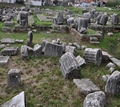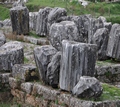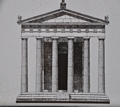
The temple of Alea Athena is one of the most important and well-known temples of the classical era, occupying a prominent position in the evolution of monumental architecture and sculpture in the Greek area. It is located in the southernmost part of the ancient Arcadian city of Tegea and today it is the only visible monument of the sanctuary of the same name, which occupied the area of the wider area and was the most important of the Arcadians, known and highly respected by all the Peloponnesians as an asylum. Pausanias (8.45.4-8.47.4) informs us that the mythical founder of the sanctuary of Alea Athena was Aleos and expresses his admiration for the temple and its sculptured decoration. He himself gives us the information that the architectural plans of the classic all-marble temple are due to one of the most famous sculptors of antiquity, Pario Scopas. Further excavations have shown that the area was intended for the worship of a female deity as early as Mycenaean times. This deity was then identified with Athena, in whose honor it was built in the last quarter of the 7th century BC monumental Doric temple, which was located under the foundations of its classical successor. This archaic temple, for which Pausanias expresses his admiration by describing it as "magnificent and worthy of sight", had wooden columns and a thrego and was destroyed by fire in 395/4 BC. The classical temple was built in the 4th century BC and was destroyed by an earthquake in the 6th century AD.
The visitor today faces the foundations of the "Skopadeian" temple, which Pausanias points out is superior to the other temples of the Peloponnese in terms of overall construction and size. It was entirely made of Dolian marble, with a cobblestone foundation and building material from the archaic temple in second use. It is a pavilion Doric temple, amphiprostyle in appearance, with clear influences from the temple of Phigalea and the Propylaia of the Acropolis of Athens. The nave was surrounded by a Doric wing of 6 x 14 columns (column dimensions 47.55 x 19.19 m). Internally, along the north and south walls of the nave, the temple was adorned with seven Corinthian semi-columns. Its main entrance was to the east with a sloping plane, while a smaller entrance existed in the middle of the north side of the nave, with a corresponding sloping level on the northern side of the platform. Inside the nave was the cult statue of the goddess Athena, entirely made of ivory, for which Pausanias reports that it was brought to Rome by Augustus himself, after his victory over Antony. In the years of Pausanias there was another statue of the goddess, and on either side the statues of Asclepius and Hygias, works of Scopus, made of Pentelic marble, while inside the temple were kept many great votives. The external form of the temple was quite modest, with the exception of the sculptural compositions of the pediments, also the work of Scopas. The annual compositions derive their theme from local legends: on the eastern pediment the heroic feat of Atalanti, who was raised in the Arcadian mountains, is praised;
Source: MINISTRY OF CULTURE AND SPORTS
odysseus.culture.gr











